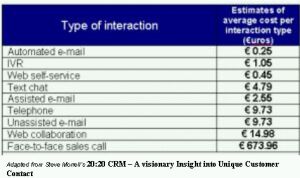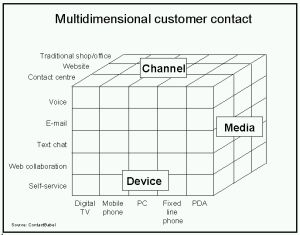 Despite new IVR and CRM solutions aimed at raising customers satisfaction and improving measurement on preferences and lifetime value, ContactBabel, an UK analysis firm, believes that future UK contact centres will always have the cost reduction issue as their overriding decision-making driver. For some, typical efficiency metrics as average speed of answer and length of call will prevail over broader effectiveness indicators. ContactBabel defends furthermore that automated systems could gradually replace low value-add agents.
Despite new IVR and CRM solutions aimed at raising customers satisfaction and improving measurement on preferences and lifetime value, ContactBabel, an UK analysis firm, believes that future UK contact centres will always have the cost reduction issue as their overriding decision-making driver. For some, typical efficiency metrics as average speed of answer and length of call will prevail over broader effectiveness indicators. ContactBabel defends furthermore that automated systems could gradually replace low value-add agents.
According to ContactBabel, the profit issue was always behind typical contact centre performance metrics as average speed of answer, length of call, calls abandoned, call waiting times and wrap-up time.
This tendency has been exacerbated by the lack of interest and support shown by board executives who view the performance of the contact centre by focusing upon the cost impact it has for their overall business, without really considering the revenue improvements which could be made with more support, the report notes.
 Outsourcing contact centres activities overseas, especially to India is a bottom-line issue today in UK. Indeed, ContactBabel predicts a tough fight between outsourcing contact centres activities overseas and automation solutions. This question emerges in the context of businesses desire to axe low value-add agents costs, especially at larger operations.
Outsourcing contact centres activities overseas, especially to India is a bottom-line issue today in UK. Indeed, ContactBabel predicts a tough fight between outsourcing contact centres activities overseas and automation solutions. This question emerges in the context of businesses desire to axe low value-add agents costs, especially at larger operations.
Low value-add agents tasks refer to simple and repetitive activities such as taking meter readings or providing customers with their bank account balances. In general, agents activity here doesnt add an extra value nor improve substantially interaction with the customer.
By contrast, on the top of the pyramid are the high value-add agents engaged in helping with technical queries and cross/up-selling based upon knowledge of customers preferences. If ContactBabel predicts automated systems will play a decisive role in the reduction of low value-add agents expenses, an ultimate good interaction with customers can only be improved by budgeting on training programmes for high value-add agents.
If there is an uptake in more cost-effective ways of dealing with low value-add transactions, there is the option to up-skill low value-add agents into performing a more important and profitable role within the contact centre. Training needs are likely to increase, and part of the savings made at the low value-add part of the business could be reinvested to move the contact centre onto a higher level, improving customer loyalty, satisfaction and resell/up-sell/cross-sell rates.
It is difficult to see a rosy future for low value-add UK agents, although inertia, some businesses desire to differentiate from automated contact centres and maintaining good industrial relations may mean that a significant proportion of low value-add UK contact centres remain in the medium-to-long term, ContactBabel adds.
Automated systems performing those low value-add agents tasks can also, according to the UK analysis firm, decrease stress and boredom among agents in a market whose staff attrition runs over 25 per cent yearly. The effect of this will be a slowing in the rate of growth of agent positions: fewer jobs will be created, but they will be of a higher quality and better paid.
New contact channels
 ContactBabels study involving over 3,000 UK call and contact centres revealed that most companies, even those which actively encourage customers to use email and web self-service, are only at the beginning of the road to providing true multimedia customer contact. The majority of ‘contact centres’ today are little more than telephony-only call centres which do some e-mail and perhaps the occasional text chat.
ContactBabels study involving over 3,000 UK call and contact centres revealed that most companies, even those which actively encourage customers to use email and web self-service, are only at the beginning of the road to providing true multimedia customer contact. The majority of ‘contact centres’ today are little more than telephony-only call centres which do some e-mail and perhaps the occasional text chat.
Web self-service, along with email management, is the most important new channel support application for businesses in general and is widely regarded as having one of the lowest costs per interaction.
But the analysis firm spotted some problems in the implementation of these technologies: internet search engines supposed to double as mavens in the resolution of complex technical problems and delayed contacts through email.
The culture of delayed email has spread into the business-to-consumer interaction model, with disastrous results. Most people would agree, receiving an email marked urgent from a superior will mean the recipient puts all other work aside to reply straightaway.
This should be the attitude of companies receiving e-mails from customers or prospects, who are usually more important to the health of the enterprise than any colleague or manager, ContactBabel concludes.
Filipe Samora
2003-02-17
Em Foco – Pessoa

